stDYDX Reward Calculator
Stake Your DYDX
Calculate your potential rewards using Stride's liquid staking mechanism. Current annual rate: 2.65% (as of October 2024).
Enter your DYDX amount and holding period to see projected rewards
How stDYDX Works
Your balance remains constant (1 stDYDX = 1 DYDX), but the redemption value increases as rewards compound daily from dYdX trading fees.
Current APY: 2.65%
Important Risk Notes:
IBC bridge security, USDC-DYDX swap slippage, and potential regulatory changes may affect actual returns. Rewards are not guaranteed.Key Takeaways
- stDYDX is a non‑rebasing liquid staking token that lets DYDX holders earn staking rewards while staying liquid.
- Rewards come from dYdX trading fees, converted from USDC to DYDX and automatically compounded.
- The token lives on the Cosmos ecosystem via Stride’s IBC‑enabled infrastructure.
- Annual reward rates hover around 2.6% as of late2024, but lock‑up periods and bridge security are the main risks.
- Getting started involves three steps: move DYDX to a Cosmos‑compatible wallet, deposit on Stride, and receive stDYDX.
What is stDYDX?
When you hear "Stride Staked DYDX" think of a bridge between two worlds: the high‑frequency trading engine of the dYdX protocol and the liquid‑staking layer built by Stride inside the Cosmos network. In plain terms, Stride Staked DYDX (stDYDX) is a non‑rebasing liquid staking derivative that represents DYDX tokens staked on the Stride chain. Users lock their DYDX, Stride stakes it on the dYdX chain, and in return you receive an equal amount of stDYDX. The token’s supply never changes; instead, its redemption value climbs as rewards compound.
Why does liquid staking matter for DYDX?
Traditional staking forces a trade‑off: lock your tokens, earn rewards, but lose the ability to trade or provide liquidity elsewhere. dYdX’s native token pays fees in USDC, not in DYDX itself, which meant early stakers faced a “DeFi hurdle rate” - they needed extra yields from other protocols to make up for the opportunity cost. By turning DYDX into a liquid staking token, Stride removes that hurdle. Holders keep a tradable asset (stDYDX) that still accrues the underlying protocol’s fee‑based rewards.
How does the reward mechanism work?
Unlike many liquid staking tokens that simply distribute native inflation, stDYDX’s rewards come from the dYdX fee pool. Here’s the flow:
- Traders on dYdX generate USDC fees.
- Every epoch, those USDC fees are collected by the dYdX Foundation.
- The fees are automatically swapped back to DYDX on a market‑neutral DEX.
- The newly minted DYDX is deposited into the same staking position, increasing the total underlying amount.
- Because stDYDX is non‑rebasing, your wallet balance stays at 1stDYDX, but the redemption rate (DYDX per stDYDX) rises - e.g., 1stDYDX can later be redeemed for 1.05DYDX after several months.
As of October2024, Coinbase reports an annualised reward rate of about 2.65%.
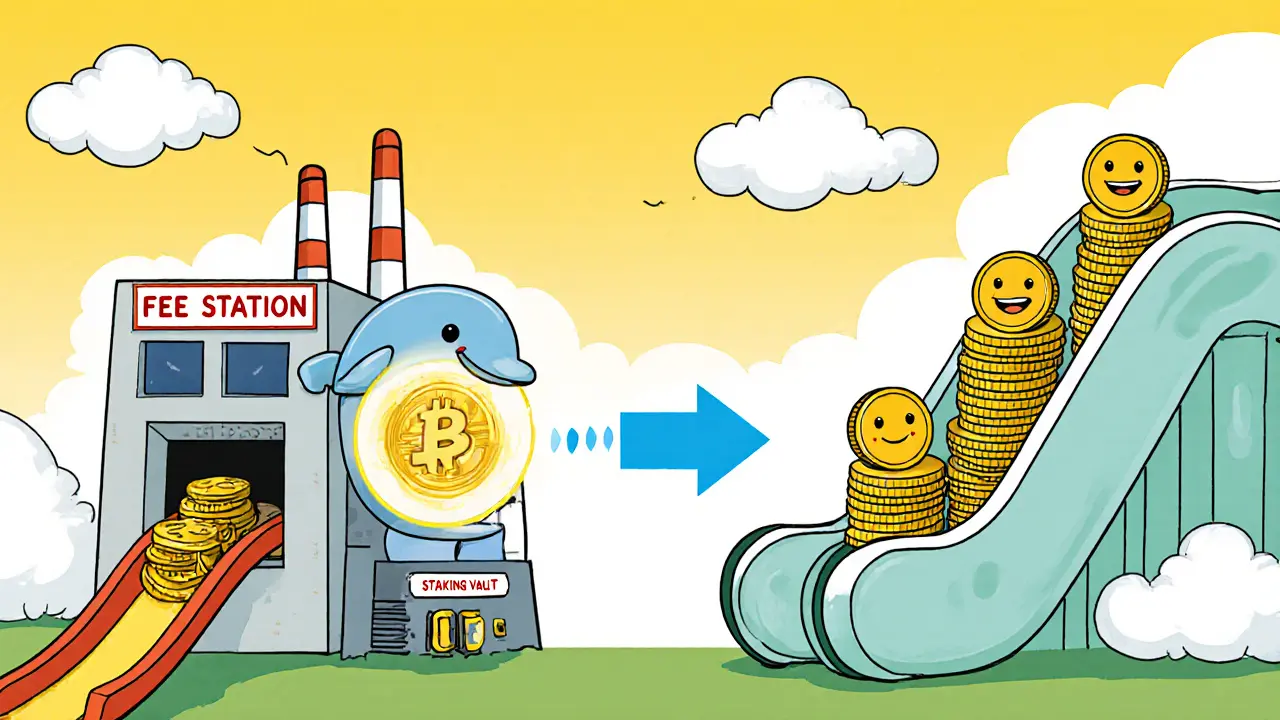
Technical foundations: Stride, Cosmos & IBC
Stride is a liquid‑staking blockchain built on the Cosmos SDK that provides the infrastructure for non‑rebasing derivatives handles the heavy lifting. The token lives on a Stride zone, which connects to the dYdX zone via Inter‑Blockchain Communication (IBC) version3. IBC lets assets move between Cosmos‑based chains without giving up security. Stride also benefits from Interchain Security, where roughly $1.4billion worth of ATOM backs the network, reinforcing its resilience.
Step‑by‑step: How to get stDYDX
If you’re ready to try it, follow these three phases. The whole process usually takes 15‑20minutes for seasoned DeFi users, and up to an hour for newcomers.
- Prepare a Cosmos‑compatible wallet. Install Keplr or Leap, create a Stride account, and back up the recovery phrase.
- Transfer DYDX. Send your DYDX from a dYdX or Ethereum wallet to the Stride address using an IBC bridge (e.g., the Stride Bridge UI). The bridge will lock the token on the dYdX zone.
- Deposit on Stride. In the Stride dashboard, select the “Stake DYDX” module, confirm the amount, and submit. Stride issues stDYDX at a 1:1 ratio instantly.
After staking, you’ll see stDYDX appear in your wallet. You can now use it in Cosmos DeFi apps (e.g., Osmosis, Gravity DEX) or keep it on an exchange like Coinbase or Bitget for easy trading.
Risks and considerations
Every opportunity comes with trade‑offs. Here’s what you should watch out for:
- Bridge security. IBC bridges are robust but not immune to bugs or governance attacks. A breach could temporarily freeze cross‑chain transfers.
- Slippage on USDC‑to‑DYDX swaps. The automatic conversion relies on market depth; during high volatility the swap price may deviate, slightly lowering reward compounding.
- Lock‑up periods. While Stride itself doesn’t impose extra lock‑ups, the underlying dYdX protocol requires a minimum stake period of a few hours to several days, which can delay unstaking.
- Centralization concerns. Stride holds >85% of the Cosmos LST market, meaning a large share of liquid‑staking security is concentrated in one provider.
- Regulatory uncertainty. Some jurisdictions may treat liquid‑staking derivatives as securities, affecting access for certain users.
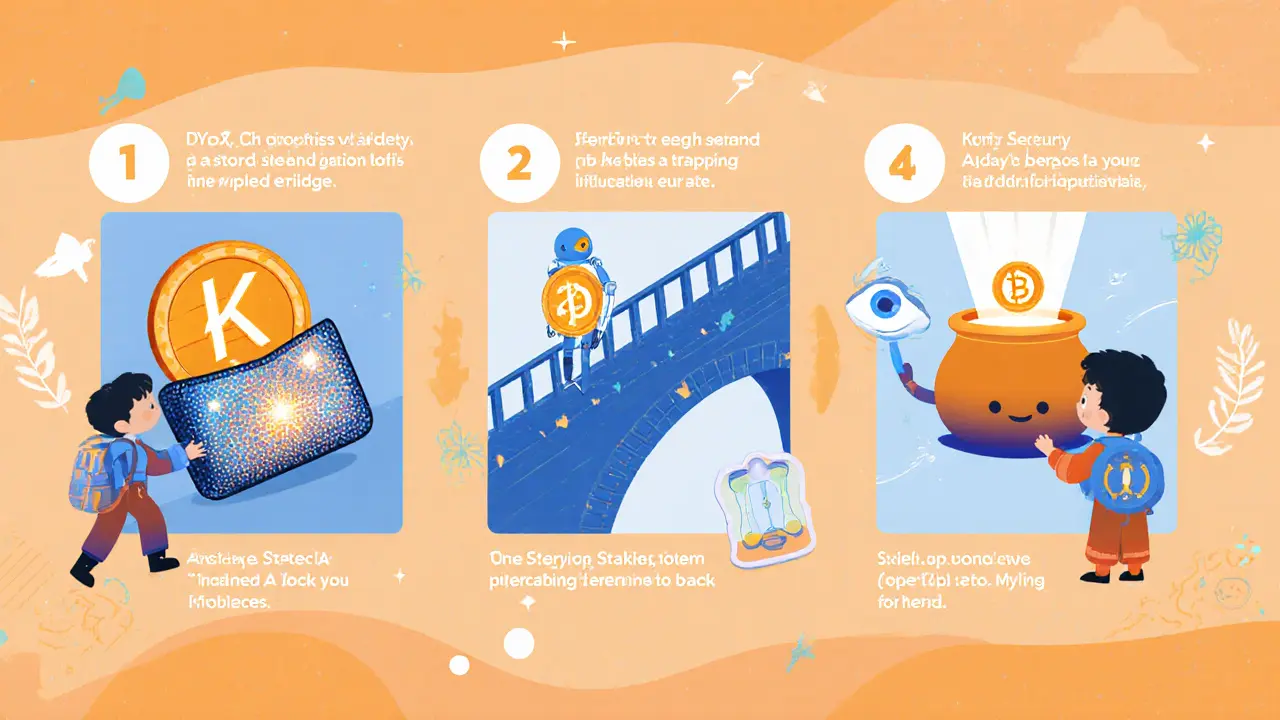
How does stDYDX compare to other liquid staking tokens?
| Feature | stDYDX | stATOM (Stride) | stETH (Lido) |
|---|---|---|---|
| Underlying token | DYDX | ATOM | ETH |
| Chain ecosystem | Cosmos (via dYdX zone) | Cosmos | Ethereum |
| Reward source | USDC fees → swapped to DYDX | ATOM inflation + fees | ETH staking rewards |
| Annual reward rate (approx.) | 2.65% | 5‑7% (inflation‑driven) | 4‑5% |
| Rebasing? | No (non‑rebasing) | No | Yes (rebasing) |
| Liquidity bridges | IBC (Cosmos) & Coinbase/Bitget listings | IBC, major exchanges | Ethereum bridges, multiple exchanges |
| Typical user base | DYDX traders, Cosmos DeFi users | Cosmos validators & investors | Ethereum DeFi participants |
From the table it’s clear that stDYDX shines for users already in the dYdX trading ecosystem or those who prefer the Cosmos cross‑chain flexibility. However, if you need a higher raw APY or operate mainly on Ethereum, stATOM or stETH might be a better fit.
Frequently Asked Questions
What does a non‑rebasing token mean for my wallet balance?
Your stDYDX amount stays the same (e.g., 100stDYDX). The token’s value grows because the redemption rate - how many DYDX you get per stDYDX - increases as rewards compound.
Can I trade stDYDX on a decentralized exchange?
Yes. Platforms like Osmosis and Gravity DEX support stDYDX swaps thanks to its IBC compatibility. Centralized exchanges such as Coinbase and Bitget also list the token.
Is there a minimum amount to stake?
Stride does not enforce a strict minimum, but most interfaces suggest at least 10DYDX to cover transaction fees comfortably.
What happens if the IBC bridge experiences downtime?
During a bridge outage, new deposits and withdrawals pause, but already‑staked positions keep earning rewards. You simply wait until the bridge is restored.
Are there tax implications for earning stDYDX rewards?
In most jurisdictions, the increase in redemption value is treated as taxable income when you claim the reward or when you sell the underlying DYDX. Consult a local tax professional for precise advice.
Bottom line
Stride Staked DYDX offers a smooth way for dYdX traders to keep their capital fluid while still tapping into the protocol’s fee‑based rewards. The token’s non‑rebasing design, Cosmos‑wide interoperability, and modest APY make it attractive for users who value simplicity over raw yield. Keep an eye on bridge health, conversion slippage, and any regulatory shifts-those are the variables that could tip the risk‑reward balance. If you’re already in the Cosmos or dYdX ecosystems, trying out a small amount of stDYDX can give you a taste of liquid staking without locking up all your assets.
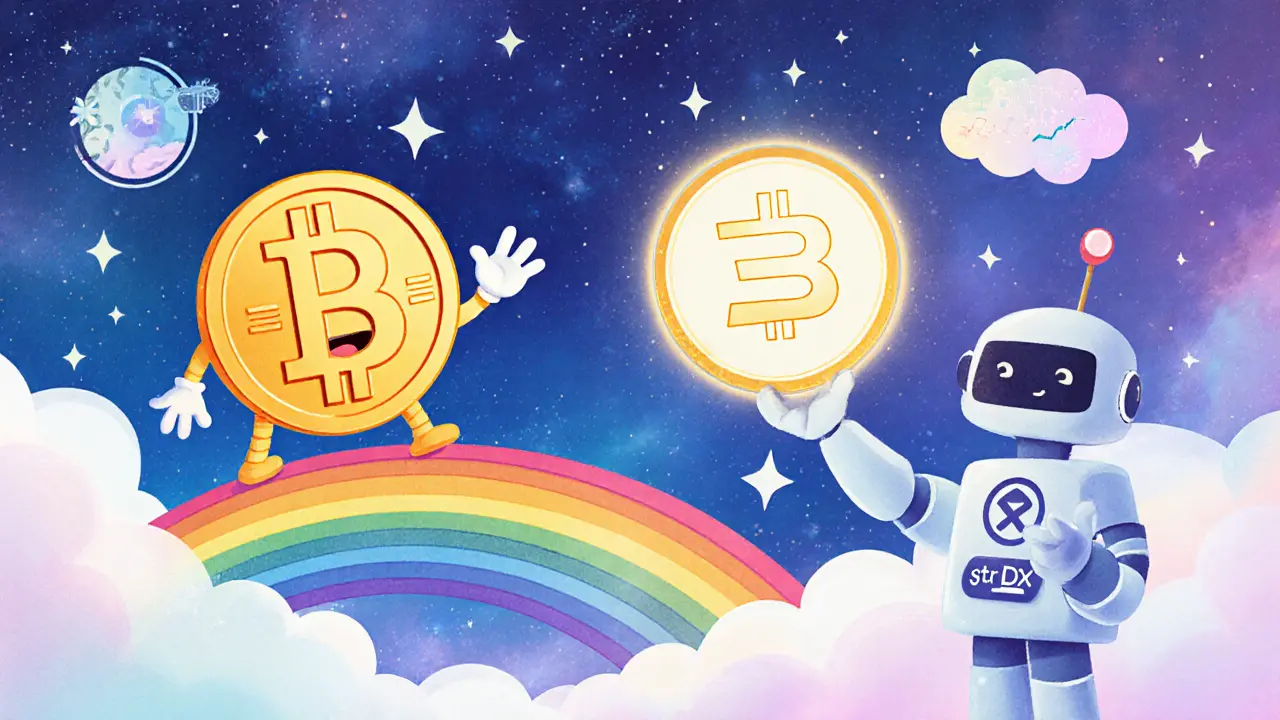
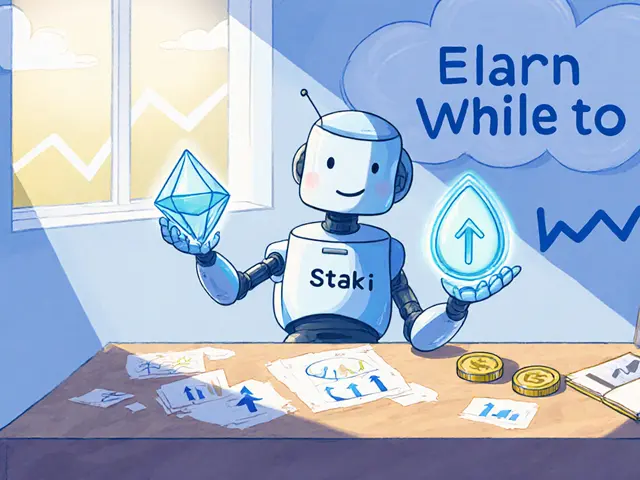
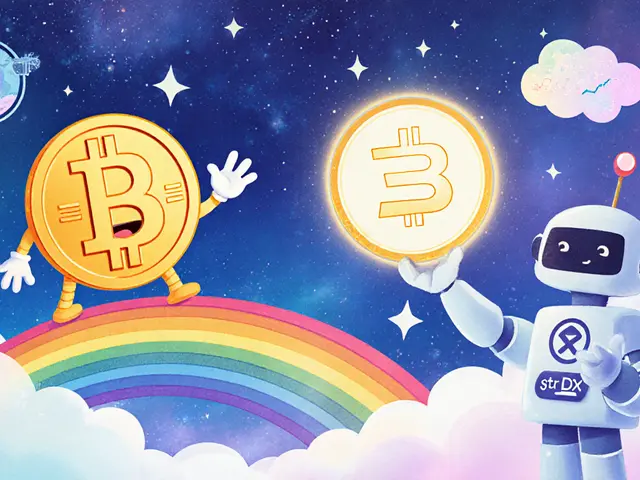
Kyla MacLaren
October 16, 2025 AT 09:14I think stDYDX looks pretty cool and easy to ues.
John Beaver
October 26, 2025 AT 19:24stDYDX is an interesting experiment that blends liquid staking with fee‑based rewards. First, you lock your DYDX on the Stride chain and receive a 1:1 representation called stDYDX. Because it’s non‑rebasing, your wallet balance never changes, but the redemption rate climbs as fees are converted back into DYDX. The fee pool on dYdX generates USDC from every trade, which is then swapped for DYDX on a market‑neutral DEX. Those newly minted DYDX tokens get restaked automatically, compounding the underlying amount. Over time, the redemption rate might go from 1.00 to 1.07 or higher, depending on trading volume. The process is fully on‑chain, so you don’t need to trust a custodial service. You can still move your stDYDX around the Cosmos ecosystem, using Osmosis or Gravity DEX for swaps. That liquidity is the key advantage over traditional staking, where your tokens are locked. The annualised APY hovers around 2.6‑2.7%, which isn’t mind‑blowing but is risk‑adjusted. One risk is the IBC bridge; if it hiccups, you could be unable to move assets for a while. Another concern is slippage when the USDC‑to‑DYDX swap occurs during volatile markets. The underlying dYdX protocol also imposes a minimum unstake period of a few hours. Security‑wise, Stride benefits from Interchain Security backed by over a billion dollars of ATOM, but it’s still a relatively young stack. In short, if you’re already trading on dYdX and want to keep capital fluid, a modest allocation to stDYDX makes sense. Just keep an eye on bridge health and reward rates before you go all‑in.
Jennifer Bursey
November 6, 2025 AT 00:01From a protocol‑architecture perspective, stDYDX leverages IBC's packet authentication to guarantee atomicity of cross‑chain staking operations. The reward vector is derived from the dYdX fee‑revenue stream, which is a deterministic function of on‑chain trade volume. Consequently, the yield curve exhibits low variance relative to inflation‑driven LSTs such as stATOM. Moreover, the non‑rebasing tokenomics sidestep balance‑inflation concerns that plague rebasing derivatives. Practitioners should therefore prioritize stDYDX when constructing a yield‑optimisation pipeline within the Cosmos DeFi stack.
Kevin Duffy
November 15, 2025 AT 23:04Nice rundown! Definitely worth a try if you’re into DYDX. 🚀💰
Kim Evans
November 25, 2025 AT 16:34Quick tip: when you set up your Keplr wallet, double‑check the address prefix (stride) before sending DYDX, otherwise the bridge will reject the transfer. Also, keep a small amount of ATOM handy to cover IBC gas fees. Once your stDYDX lands, you can farm additional incentives on Osmosis by providing liquidity to the stDYDX/ATOM pool.
Linda Campbell
December 5, 2025 AT 04:31The United States has long been at the forefront of financial innovation, and mechanisms such as stDYDX exemplify the brilliance of our domestic developers. It is imperative that we continue to support home‑grown blockchain solutions rather than ceding leadership to foreign entities.